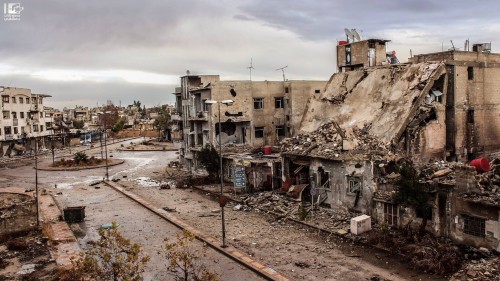PHOTO: Jobar in northeast Damascus
Sam Dagher writes for The Wall Street Journal:
As hundreds of thousands of refugees flee Syria for Europe, the regime of President Bashar al-Assad has been coming down hard on those who have stayed behind, particularly people viewed as potential threats.
Ahmed al-Hamid is one of them. The 37-year-old doctor said security agents picked him up in late 2013 for his role establishing field hospitals in opposition areas in Homs and Damascus. After six months in jail — where he said he was beaten with batons and whips while strapped to boards — Dr. Hamid was released by a sympathetic judge. Last year, he fled to nearby Lebanon, joining an exodus of professionals, dissidents and others who were driven out for being on the wrong side of the Syrian regime.
“There is no order, per se, but all conditions are being put in place so that people do not dare go back,” says Dr. Hamid, a stocky man with a shaved head.
Refugees from Syria’s multi-sided civil war have fueled Europe’s migrant crisis. More than half the nearly 400,000 who have arrived in Europe by sea so far this year are Syrian, according to the United Nations Refugee Agency.
The West has focused largely on those fleeing Islamic State and its atrocities, but Mr. Assad’s regime hasn’t relented with the intimidation and force it has used since the start of the conflict more than four years ago: detention, torture and mandatory drafting into the army for military-age men, along with starvation and an aerial bombing campaign of opposition-held areas. His government has also offered subtle incentives to leave, such as an easier time obtaining a Syrian passport and less hassle booking flights to foreign countries.
The regime’s tactics are pushing out its opponents and those perceived hostile to Mr. Assad, while friendlier groups are rebuilding from the wreckage of war. The cumulative results are broader demographic change designed to tighten Mr. Assad’s hold over the few places he still controls.
Many Syrians say the Assad regime, along with the Iran-backed Lebanese Shiite militia Hezbollah, is specifically targeting Syria’s Sunni Arab majority. Syria’s rebels are mostly Sunni, while those defending the regime are mainly members of Mr. Assad’s Shiite-linked Alawite minority and Shiite foreign fighters….
In Damascus, the demographic changes aimed at surrounding Mr. Assad with regime-friendly groups are increasingly visible. Many residents say parts of the city’s historic quarter are now unrecognizable because of the growing presence of Iran-trained Syrian Shiite militiamen and their families.
Several predominantly Sunni areas around Damascus have been recently recaptured by the regime and its allies, prompting most residents who are seen as sympathetic to the opposition to flee. Syrian officials say they are proceeding with an ambitious urban renewal plan that seeks to construct better housing and infrastructure, and that there are no broader efforts to repopulate cities with people friendly to the regime.
“Our current preoccupation is people’s return,” said Homs governor Talal al-Barazi, who was appointed by Mr. Assad. “Demographic changes in any area are forbidden.”
A 27-year-old mechanical engineer and opposition activist, who asked not to be identified because his family remains in the eastern suburbs of Damascus, estimates that only 500,000 civilians are left in the area. That’s about one-third the number from two years ago, when the regime was blamed for a major chemical weapons attack on the area.
Since then the regime has kept up its bombardment of the area. In August, 556 people, including 123 children, were killed in regime airstrikes on the area, according to tallies released by local medics.
The activist arrived in Beirut last month after paying to be smuggled out through a tunnel that connects the eastern suburbs with Damascus. Many Syrians who come to Lebanon are looking to move on to Europe. And those who had settled temporarily in Tripoli are doing the same.

